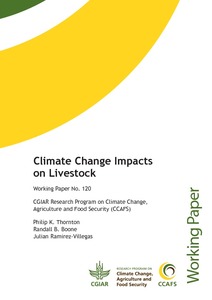CCAFS Baseline Survey Indicators for Borana/Yabero, Ethiopia
This document series compiles key indicators from the three levels of the baseline for each site. Indicators include: demography and basic site characteristics of each site, rainfall distribution, changes in farming practices and land management, income sources, food security and food
sources, asset ownership by households and involvement in organisations and more. This CCAFS baseline indicator document was developed for the CCAFS site at Borana/Yabero, in Ethiopia.
CCAFS Business Plan 2012
2012 will be the second year of operation of the CGIAR research program on Climate Change, Agriculture and Food Security (CCAFS). The 2012 business plan lays out the key activities in 2012, situated within the larger strategic framework of CCAFS. At the time of writing, many of the overarching principles for the operation of CGIAR Research Programs (CRPs) are still being produced by the Consortium Office (e.g. monitoring and evaluation strategy), so some of the proposed activities in 2012 may need to be modified as the year unfolds.
CCAFS Mitigation Options Tool
The University of Aberdeen and CCAFS are developing a simple tool for practitioners to quickly identify and compare mitigation options for agriculture. The CCAFS-MOT tool takes account of current farming practices and growing conditions to suggest a wide range of
mitigation options. The Excel-based tool is free and downloadable from the CCAFS website.
Changing rainfall patterns and farmers ’ adaptation through soil water management practices in semi- arid eastern Kenya
There is limited documentation of soil and water management technologies that enhance adaptation to climate change in drylands of Kenya. Rainfall patterns were analyzed in the semi-arid Machakos and Makueni counties of eastern Kenya using historical data. A total of forty-three smallholder farmers implementing soil water management practices were sampled, and an estimate of the seasonal water budget for current crop and livestock production systems computed.
Characterization of food consumption patterns in Southern Mali: Districts of Bougouni and Koutiala Sikasso
Climate change adaptation in agriculture: practices and technologies. Opportunities for climate action in agricultural systems
In this info note we provide a brief overview of key
agricultural practices and technologies which enhance
productivity in a sustainable manner, thus contributing to
food security and environmental goals while increasing
the resilience of farming systems.
A twinned info note considers
higher-level measures of
adaptation in agriculture, such
as policies and institutions. Updated: November 2016.
Both info notes are drawn from
longer working papers, all
freely available to download at
Climate change adaptation in mixed crop?livestock systems in developing countries
Mixed crop?livestock systems produce most of the world’s milk and ruminant meat, and are
particularly important for the livelihoods and food security of poor people in developing
countries. These systems will bear the brunt of helping to satisfy the burgeoning demand
for food from increasing populations, particularly in sub?Saharan Africa and South Asia,
where rural poverty and hunger are already concentrated. The potential impacts of changes
in climate and climate variability on these mixed systems are not that well understood,
Climate change impacts and mitigation in the developing world: an integrated assessment of the agriculture and forestry sectors
This paper conducts an integrated assessment of climate change impacts and climate mitigation on agricultural commodity markets and food availability in low- and middle-income countries. The analysis uses the partial equilibrium model GLOBIOM to generate scenarios to 2080. The findings show that climate change effects on the agricultural sector will increase progressively over the century. By 2030, the impact of climate change on food consumption is moderate but already twice as large in a world with high inequalities than in a more equal world.
Climate Change Impacts on Livestock
This Working Paper summarizes projected climate change impacts on livestock across
Africa, using a combination of literature review and some new results on the projected
impacts of climate change on the rangelands of Africa. Findings show that there are
many options that can help livestock keepers adapt, but there appear to be no options
that are widely applicable which do not have constraints to their adoption. An
enabling technical and policy environment will thus be needed to ensure livestock
Climate change, agriculture and food security: a strategy for change
Agriculture – on which we all depend for our food – is under threat from climate change. There is no doubt that systems worldwide will have to adapt, but while consumers may barely notice in developed countries, millions of people in developing countries face a very real and direct threat to their food security and livelihoods. Even without climate change, many agricultural systems in developing countries are nearing crisis point. Feeding a rapidly rising global population is taking a heavy toll on farmlands, rangelands, fisheries and forests. Water is becoming scarce in many regions.











